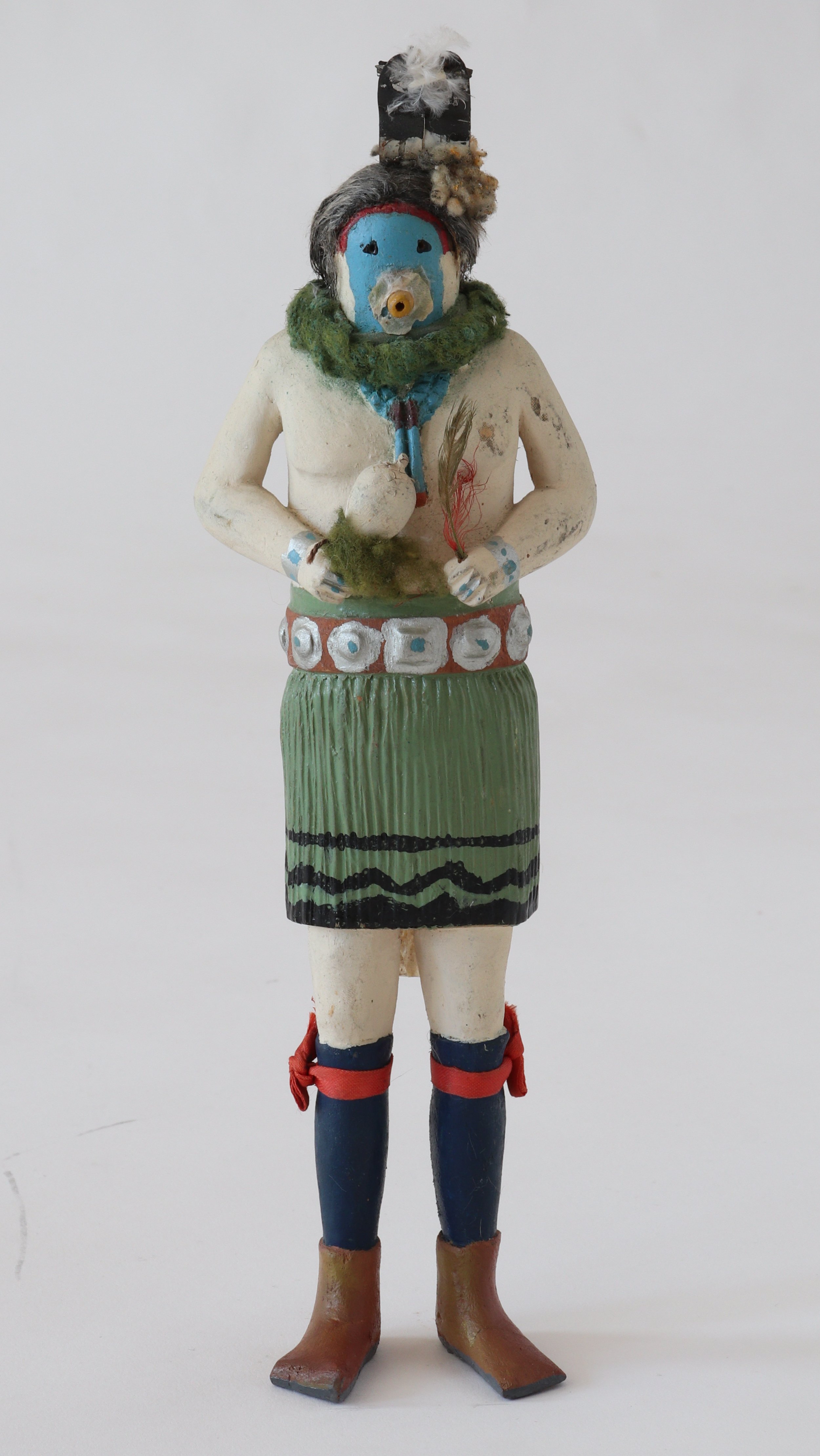Clitso Dedman (Navajo/Diné, 1879?-1953)
Figural Group (Nightway Ceremony), c. 1950
Polychromed cottonwood with wool, tin, and feathers
Each figure approx 9 3/4 x 3 x 3 in. (24.77 x 7.62 x 7.62 cm)
Carved out of cottonwood, carefully painted, and festooned with tin feathers, wool, leather, and hair, this set of sixteen figures by Clitso Dedman depicts the Nightway ceremony, a significant religious healing ritual for the Navajo (Diné) people. The figures capture the individuality of the ceremony’s participants—each carved dancer has minute differences in height and physique, a trademark of Dedman's output [figs. 1, 2]. The set includes a priest and a patient, who is shown holding the basket at the front of the group. They stand before a procession of twelve Yei Bi Chei dancers, each wearing blue masks, led by the Talking God, who wears a white mask with a cornstalk at its center. The Water Sprinkler, a clown figure, brings up the rear of the procession. Dedman used tufts of green-dyed wool to represent the spruce branches that this figure would have worn. While his early figures were almost entirely carved,Dedman began using materials such as stamped and painted tin for feathers and tufts of wool for spruce as he grew older and slowly lost dexterity in his hands.1 He also relied on his wife and son to assist him with the production of the figures, making the later sets, such as this one, somewhat collaborative efforts.
Dedman only began carving figures toward the end of his eventful life in the 1940s, first as gifts for the daughters of trading post owner Cozy McSparron and later as a means of income. Born in northern Arizona in about 1879, like many Native children in the nineteenth and twentieth centuries, Dedman was taken from his family by the Federal Government and sent to boarding school. At the Grand Junction Indian School (also known as the Teller Institute) in Colorado, he learned to read and write in English, as well as some of the vocational skills he would later use to support himself and his family. After he returned to Arizona, Dedman’s long list of occupations included work as a mechanic, a stonemason, and a chauffeur for trading post owner John Lorenzo Hubbel. He also held the distinction of being one of the few Diné men to operate his own trading post, a profession with significant social weight in Native communities that was nevertheless held almost entirely by Euro-American men. Theodore Roosevelt, during a visit to Arizona, met Dedman and remarked on the artist’s charm and monetary success, attributing them to what he believed to be evidence of the success of the residential school system.2
This group of sixteen figures, one of only a few complete sets of carvings by the artist, is unique for a number of reasons. Whereas other comparable examples typically only included male dancers impersonating female Yei Bi Chei (distinguished by square masks), this set of figures includes female participants. The care Dedman bestowed on the creation of the figures can be seen in the female dancer’s concho belts, which are carved and painted as if glimpsed through their long hair [fig 3]. Additionally, the accuracy of the figures’ masks is unlike that of other pieces by the artist. As a convert to Catholicism, Dedman may have felt more comfortable depicting a sacred ritual for the Navajo people. Still, he altered the masks of the dancers in other known examples of his work, perhaps as a sign of respect and in an attempt to conceal the true nature of the ceremony, a convention continued by many Navajo artists today. The reasons for his decision to accurately depict the dancers in this set are now lost. Regardless, the sixteen figures depicted here speak not only to the impact of the ritual on the artist’s life, but, in their delicately rendered dress and physiques, to the profound humanism of Dedman’s work.
1 For a comprehensive biography of Dedman, see Vallette, Rebecca M. and Jean-Paul, “The Life and Work of Clitso Dedman, Navajo Woodcaver (1879?-1953),” American Indian Art Magazine 24, no. 2 (Spring 2000), 54-67.
2 Theodore Roosevelt, “The Hopi Snake Dance,” The Outlook 105 (October 1-8, 1913), 365-6.



